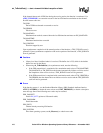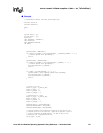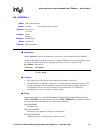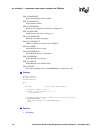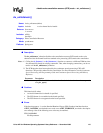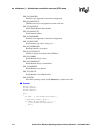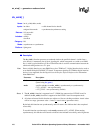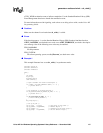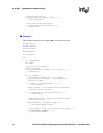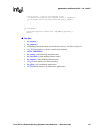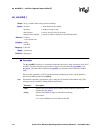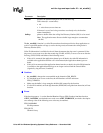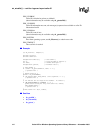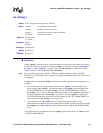
436 Voice API for Windows Operating Systems Library Reference — November 2003
dx_wink( ) — generate an outbound wink
dx_wink( )
generate an outbound wink
!
!!
! Description
The dx_wink( ) function generates an outbound wink on the specified channel. A wink from a
voice board is a momentary rise of the A signaling bit, which corresponds to a wink on an E&M
line. A wink’s typical duration of 150 to 250 milliseconds is used for communication between the
called and calling stations on a T-1 span.
Note: Do not call this function on a non-E&M line or for a TDM bus T-1 digital interface device such as
on an Intel® Dialogic® D/240SC-2T1 board. Transparent signaling for TDM bus digital interface
devices is not supported. See the Digital Network Interface Software Reference for information
about E&M lines.
Notes: 1. The dx_wink( ) function is supported on a T-1 E&M line connected to a DTI/101 board. In
addition, the dx_wink( ) function is supported on the DTI/211 board in transparent mode.
2. All values referenced for this function are subject to a 10 msec clocking resolution. Actual values
will be in a range: (parameter value - 9 msec) <
actual value < (parameter value)
By default, this function runs synchronously, and will return a 0 to indicate that it has completed
successfully.
To run this function asynchronously set the mode parameter to EV_ASYNC. When running
asynchronously, this function will return 0 to indicate it has initiated successfully, and will generate
Name: int dx_wink(chdev, mode)
Inputs: int chdev
• valid channel device handle
unsigned short mode
• synchronous/asynchronous setting
Returns: 0 if successful
-1 if failure
Includes: srllib.h
dxxxlib.h
Category: I/O
Mode: asynchronous or synchronous
Platform: Springware
Parameter Description
chdev specifies the valid channel device handle obtained when the channel was
opened using dx_open( )
mode specifies whether to run dx_wink( ) asynchronously or synchronously:
• EV_ASYNC – run asynchronously
• EV_SYNC – run synchronously (default)



